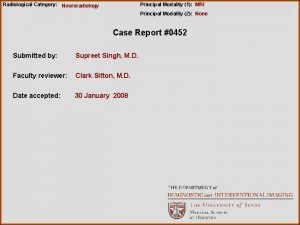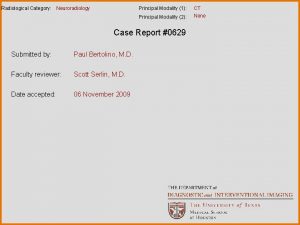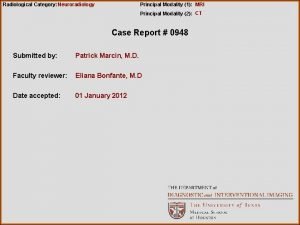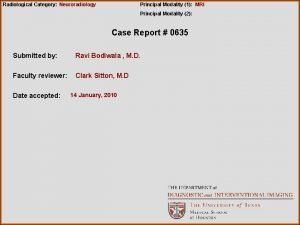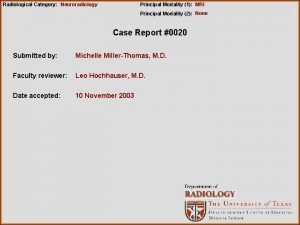Radiological Category Neuroradiology Principal Modality 1 MRI Principal










- Slides: 10

Radiological Category: Neuroradiology Principal Modality (1): MRI Principal Modality (2): None Case Report #0320 Submitted by: Justin Ord, M. D. Faculty reviewer: Leo Hochauser, M. D. Date accepted: 15 March 2006

Case History • 50 year old with headache.

Radiological Presentations

Test Your Diagnosis Which one of the following is your choice for the appropriate diagnosis? After your selection, go to next page. Venous Angioma AVM Capillary Telangiectasia Cavernous Hemangioma

Findings and Differentials Findings: Axial T 1 and T 2 and saggital T 1 MR images demonstrate a lesion with heterogeneous signal on both T 1 and T 2, centered in the mid pons. This has a rim of low signal on T 2.

Discussion • Capillary Telangiectasia: Capillary Telangiectasias are often located in the pons, are fairly large (measuring 3 cm on average). They are difficult to diagnose because the vast majority do not hemorrhage, and are only noted as nodular enhancement on T 1 post contrast images. A key feature is that there is normal interposed brain. These are rarely associated with Osler-Weber-Rendu or Hereditary Hemorrhagic Telangiectasia. The location fits perfectly for our patient, in the mid pons. However, these are unenhanced images, and the lesion is clearly visible. Also, the lesion is smaller than the average telangiectasia. Something else fits better.

Discussion • Venous Angioma: Venous angiomas, or malformations, consist of a network of dilated medullary veins converging into a large draining vein that drains into superficial or deep veins. The surrounding brain parenchyma is normal. They are diagnosed on MR by observing linear structures with flow voids, usually adjacent to a venricle with uniform enhancement. They are occasionally associated with a cavernous hemangioma. A Venous angioma represents a drainage route for normal brain, and sacrifice of this pathway can produce venous infarction. These are often also evaluated with angiography. This doesn't fit well either. Venous angiomas are best seen on enhanced images (not shown), and are not often associated with blood products. No flow voids are noted.

Discussion • AVM: True AVM's contain one or more enlarged feeding arteries and have enlarged early draining veins. The feeding arteries are usually dilated, and there is a cluster of vascular loops which is called a core or nidus, and then finally the enlarged draining vein or veins. They often demonstrate curvilinear calcification and also enhance. On MR there are flow voids due to fast flow. There may be associated hemorrhage. The definitive study is cerebral angiography demonstrating the above findings. Again, this doesn't fit well either. Although AVM's can be associated with blood products, are best seen on enhanced images (not shown), and no flow voids are noted.

Discussion • Cavernous Hemangioma: Cavernous hemangiomas are considered congenital vascular hamartomas consisting of a sinusoidal collection of blood vessels without interspersed normal brain. They may cause seizures or other neurologic symptoms, but are often asymptomatic. They may also hemorrhage. They can occur anywhere, including the spine. They often have calcifications, enhance, and usually demonstrate blood products of varying ages. On MR, classically a hemosiderin rim is seen with low T 2 signal which completely surrounds the collection. Often these lesions are angiographically occult. This fits well with our patient's imaging. The location doesn't help us much, but the heterogenous signal, representing blood products of varying ages, and the complete rim of hemosiderin are virtually diagnostic.

Diagnosis Cavernous Hemangioma






